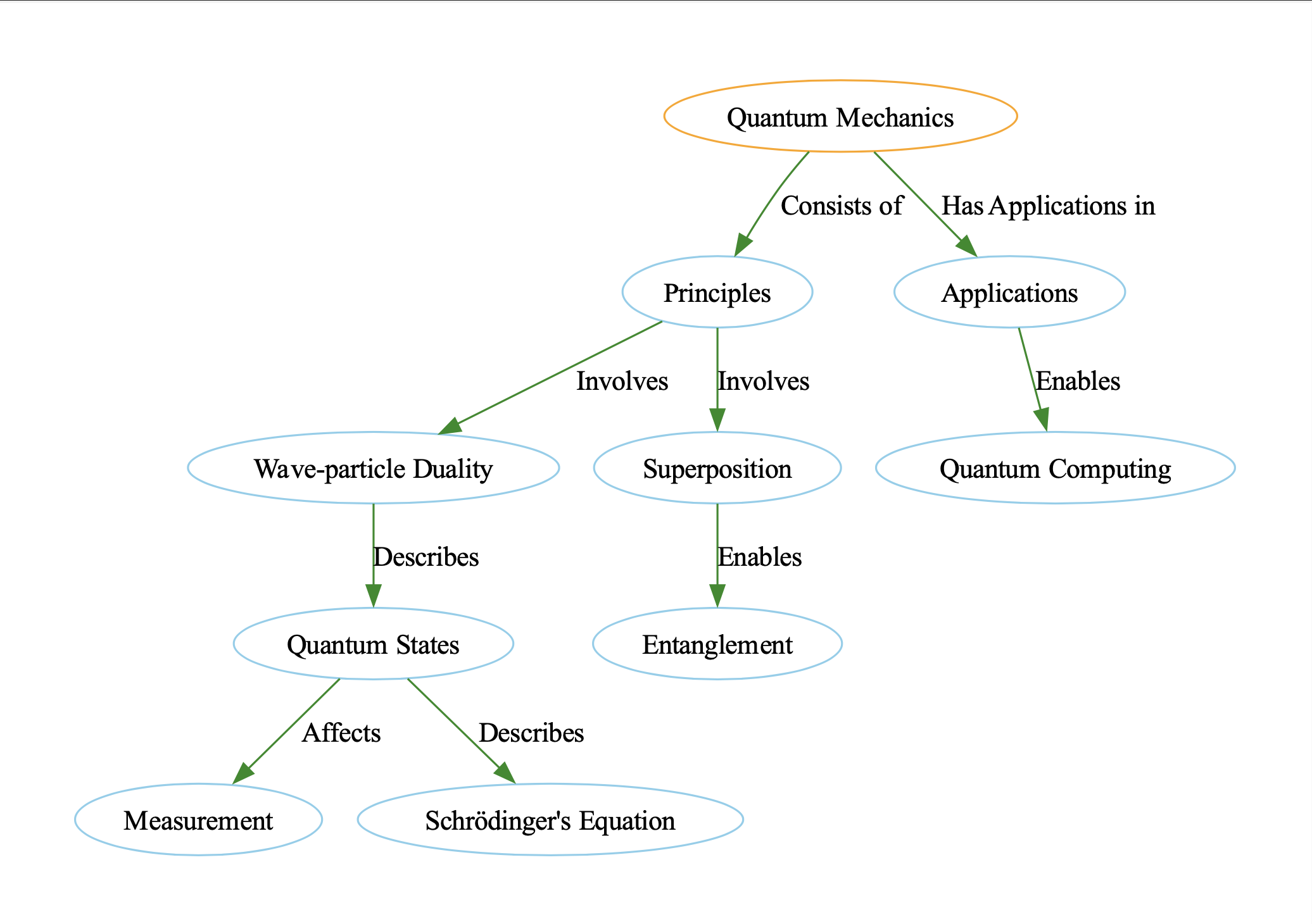Visualizing Knowledge Graphs for Complex Topics¶
In this guide, you'll discover how to visualise a detailed knowledge graph when dealing with complex topics. We'll then move on to iteratively updating our knowledge graph with new information through a series of sequential api calls using only the Instructor library, Pydantic and Graphviz to visualise our graph.
Motivation
Knowledge graphs offer a visually appealing and coherent way to understand complicated topics like quantum mechanics. By generating these graphs automatically, you can accelerate the learning process and make it easier to digest complex information.
Defining the Structures¶
Let's model a knowledge graph with Node and Edge objects. Node objects represent key concepts or entities, while Edge objects indicate the relationships between them.
from pydantic import BaseModel, Field
from typing import List
class Node(BaseModel):
id: int
label: str
color: str
class Edge(BaseModel):
source: int
target: int
label: str
color: str = "black"
class KnowledgeGraph(BaseModel):
nodes: List[Node] = Field(..., default_factory=list)
edges: List[Edge] = Field(..., default_factory=list)
Generating Knowledge Graphs¶
The generate_graph function leverages OpenAI's API to generate a knowledge graph based on the input query.
from openai import OpenAI
import instructor
# Adds response_model to ChatCompletion
# Allows the return of Pydantic model rather than raw JSON
client = instructor.from_openai(OpenAI())
def generate_graph(input) -> KnowledgeGraph:
return client.chat.completions.create(
model="gpt-3.5-turbo",
messages=[
{
"role": "user",
"content": f"Help me understand the following by describing it as a detailed knowledge graph: {input}",
}
],
response_model=KnowledgeGraph,
) # type: ignore
Visualizing the Graph¶
The visualize_knowledge_graph function uses the Graphviz library to render the generated knowledge graph.
from graphviz import Digraph
def visualize_knowledge_graph(kg: KnowledgeGraph):
dot = Digraph(comment="Knowledge Graph")
# Add nodes
for node in kg.nodes:
dot.node(str(node.id), node.label, color=node.color)
# Add edges
for edge in kg.edges:
dot.edge(str(edge.source), str(edge.target), label=edge.label, color=edge.color)
# Render the graph
dot.render("knowledge_graph.gv", view=True)
graph = generate_graph("Teach me about quantum mechanics")
visualize_knowledge_graph(graph)

This will produce a visual representation of the knowledge graph, stored as "knowledge_graph.gv". You can open this file to explore the key concepts and their relationships in quantum mechanics.
Iterative Updates¶
Now that we've seen how to generate a knowledge graph from a single input, let's see how we can iteratively update our knowledge graph with new information, or when information does not fit into a single prompt.
Let's take an easy example where we want to visualise the combined knowledge graph that the following sentences represent.
text_chunks = [
"Jason knows a lot about quantum mechanics. He is a physicist. He is a professor",
"Professors are smart.",
"Sarah knows Jason and is a student of his.",
"Sarah is a student at the University of Toronto. and UofT is in Canada",
]
Updating Our Data Model¶
To support our new iterative approach, we need to update our data model. We can do this by adding helper methods update and draw to our Pydantic models. These methods will simplify our code and allow us to easily visualize the knowledge graph.
In the KnowledgeGraph class, we have migrated the code from the visualize_knowledge_graph method and added new lists for nodes and edges.
class KnowledgeGraph(BaseModel):
nodes: Optional[List[Node]] = Field(..., default_factory=list)
edges: Optional[List[Edge]] = Field(..., default_factory=list)
def update(self, other: "KnowledgeGraph") -> "KnowledgeGraph":
"""Updates the current graph with the other graph, deduplicating nodes and edges."""
return KnowledgeGraph(
nodes=list(set(self.nodes + other.nodes)),
edges=list(set(self.edges + other.edges)),
)
def draw(self, prefix: str = None):
dot = Digraph(comment="Knowledge Graph")
for node in self.nodes: # (1)!
dot.node(str(node.id), node.label, color=node.color)
for edge in self.edges: # (2)!
dot.edge(
str(edge.source), str(edge.target), label=edge.label, color=edge.color
)
dot.render(prefix, format="png", view=True)
- We iterate through all the nodes in our graph and add them to the graph
- We iterate through all the edges in our graph and add them to the graph
We can modify our generate_graph function to now take in a list of strings. At each step, it'll extract out the key insights from the sentences in the form of edges and nodes like we've seen before. We can then combine these new edges and nodes with our existing knowledge graph through iterative updates to our graph before arriving at our final result.
def generate_graph(input: List[str]) -> KnowledgeGraph:
cur_state = KnowledgeGraph() # (1)!
num_iterations = len(input)
for i, inp in enumerate(input):
new_updates = client.chat.completions.create(
model="gpt-3.5-turbo-16k",
messages=[
{
"role": "system",
"content": """You are an iterative knowledge graph builder.
You are given the current state of the graph, and you must append the nodes and edges
to it Do not procide any duplcates and try to reuse nodes as much as possible.""",
},
{
"role": "user",
"content": f"""Extract any new nodes and edges from the following:
# Part {i}/{num_iterations} of the input:
{inp}""",
},
{
"role": "user",
"content": f"""Here is the current state of the graph:
{cur_state.model_dump_json(indent=2)}""",
}, # (2)!
],
response_model=KnowledgeGraph,
) # type: ignore
# Update the current state
cur_state = cur_state.update(new_updates) # (3)!
cur_state.draw(prefix=f"iteration_{i}")
return cur_state
-
We first initialise an empty
KnowledgeGraph. In this state, it has zero nodes and edges -
We then add in the current state of the graph into the prompt so that the model knows what new information needs to be added
-
We then update the nodes and edges of our graph with the information that our model has returned before visualizing the new changes
Once we've done this, we can now run this new generate_graph function with the following two lines.
Conclusion¶
We've seen how we can use Instructor to obtain structured outputs from the OpenAI LLM API but you could use that for any of the other open-source models that the library is compatible with. If you enjoy the content or want to try out Instructor check out the github and don't forget to give us a star!